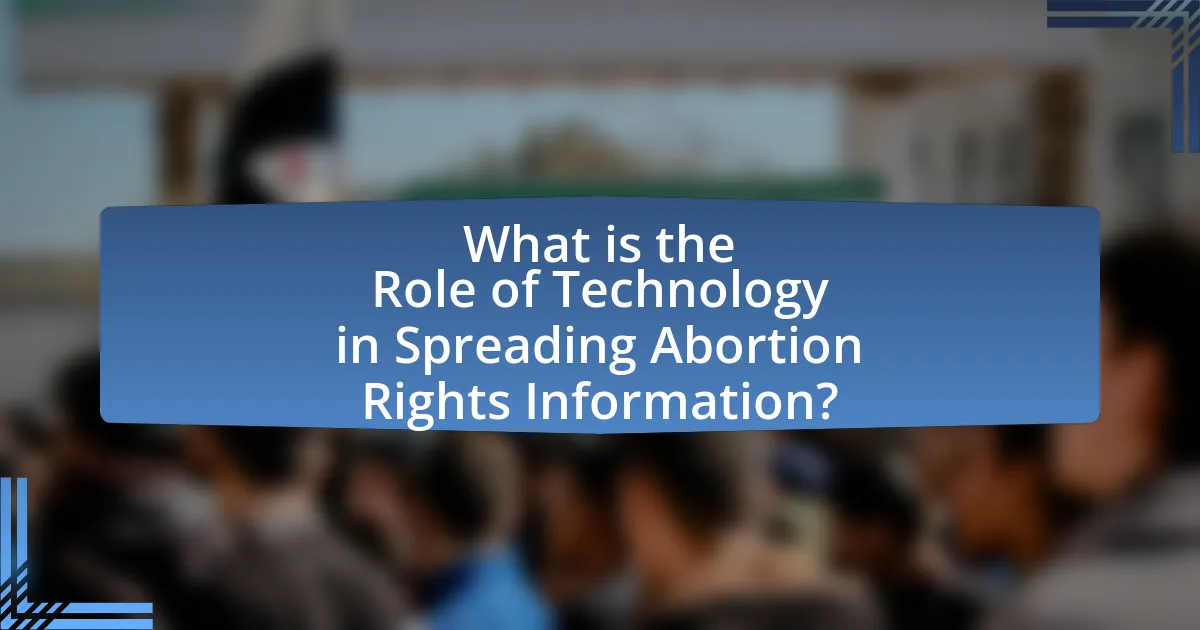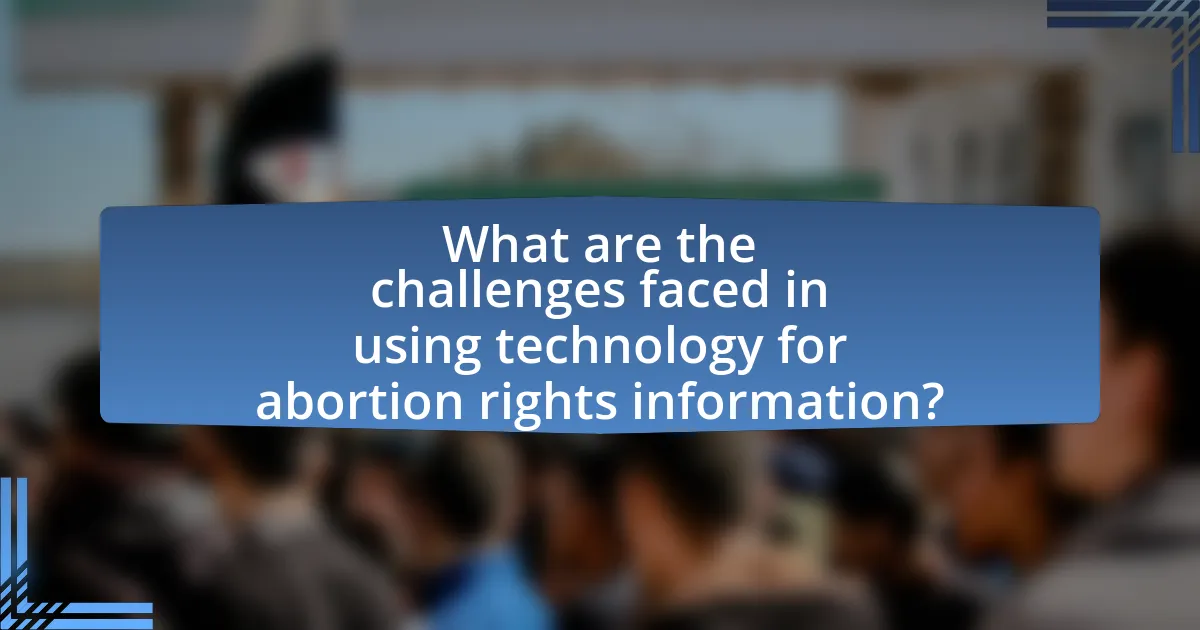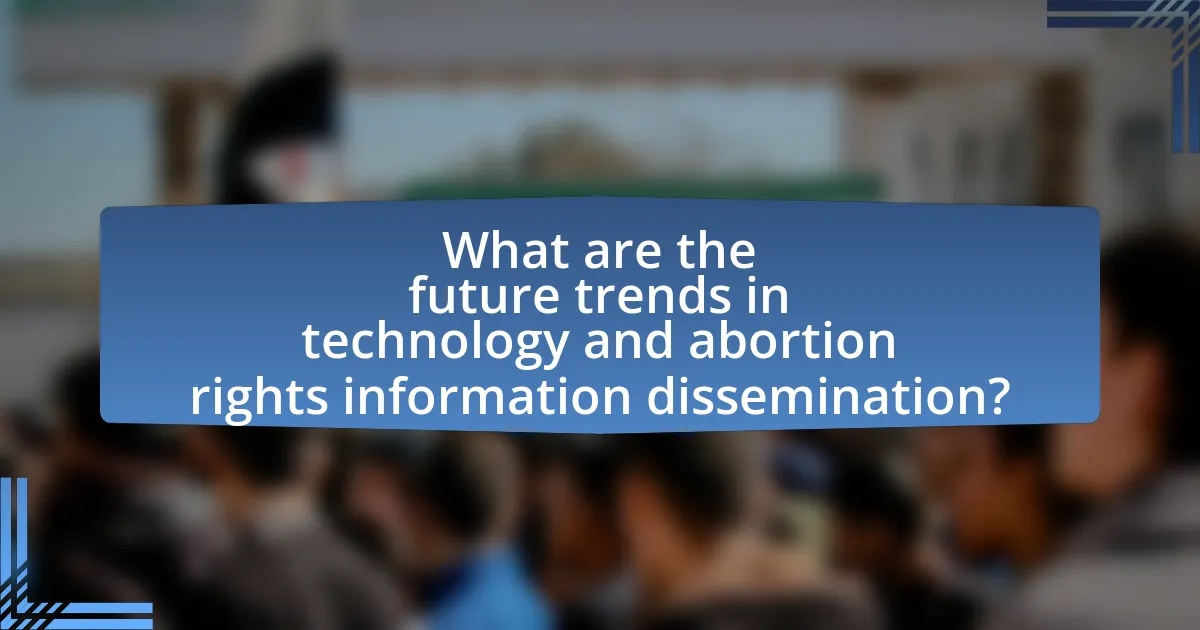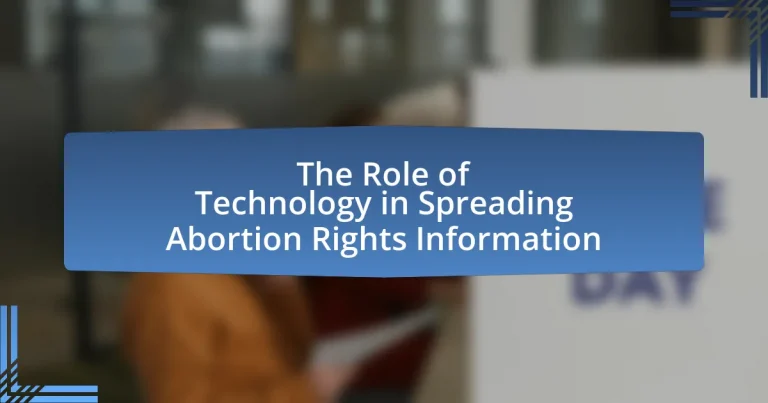The article examines the critical role of technology in disseminating information about abortion rights. It highlights how digital platforms, including social media, websites, and mobile applications, enhance access to resources, facilitate communication, and mobilize advocacy efforts. Key findings indicate that technology significantly increases awareness and understanding of reproductive rights, particularly in areas with restrictive laws. The article also addresses challenges such as misinformation, digital divides, and privacy concerns, while exploring strategies for effective engagement and the future trends in technology that will shape abortion rights advocacy.

What is the Role of Technology in Spreading Abortion Rights Information?
Technology plays a crucial role in spreading abortion rights information by facilitating access to resources, enhancing communication, and mobilizing advocacy efforts. Digital platforms, such as social media, websites, and mobile applications, enable organizations and individuals to disseminate accurate information about reproductive rights, legal options, and available services. For instance, a study by the Guttmacher Institute found that online resources significantly increase awareness and understanding of abortion rights among users, particularly in regions with restrictive laws. Additionally, technology allows for real-time updates on legislative changes and provides a platform for grassroots movements to organize and amplify their messages, thereby fostering a more informed public discourse on abortion rights.
How has technology influenced the dissemination of abortion rights information?
Technology has significantly influenced the dissemination of abortion rights information by enabling rapid and widespread access to resources and support networks. Digital platforms, including social media, websites, and mobile applications, facilitate the sharing of information regarding legal rights, healthcare options, and advocacy efforts. For instance, a study by the Guttmacher Institute in 2021 highlighted that 75% of individuals seeking abortion information utilized online resources, demonstrating the reliance on technology for accessing critical information. Additionally, technology allows for real-time updates on legislative changes and mobilizes grassroots campaigns, enhancing community engagement and awareness.
What types of technology are most effective in spreading this information?
Social media platforms are the most effective technology for spreading abortion rights information. These platforms, such as Twitter, Facebook, and Instagram, enable rapid dissemination of information to large audiences, facilitating engagement and discussion. According to a study by the Pew Research Center, 69% of adults in the U.S. use social media, making it a powerful tool for advocacy and awareness campaigns. Additionally, mobile applications and websites dedicated to reproductive health provide accessible resources and support, further amplifying the reach of abortion rights information.
How do social media platforms contribute to the conversation around abortion rights?
Social media platforms significantly contribute to the conversation around abortion rights by facilitating the rapid dissemination of information and enabling diverse voices to participate in the dialogue. These platforms allow users to share personal experiences, mobilize support, and organize advocacy efforts, which can influence public opinion and policy decisions. For instance, during the 2022 U.S. Supreme Court decision on Dobbs v. Jackson Women’s Health Organization, platforms like Twitter and Instagram became critical spaces for activists to share real-time updates, educational content, and calls to action, reaching millions of users. Research indicates that social media campaigns can increase awareness and engagement on reproductive rights issues, demonstrating their effectiveness in shaping the narrative surrounding abortion rights.
Why is technology important for abortion rights advocacy?
Technology is important for abortion rights advocacy because it facilitates the rapid dissemination of information and mobilizes support for reproductive rights. Digital platforms enable activists to share resources, connect with communities, and organize campaigns efficiently. For instance, social media has been instrumental in raising awareness and fostering discussions around abortion rights, as evidenced by the widespread use of hashtags like #ShoutYourAbortion, which has reached millions of users. Additionally, technology allows for the creation of online petitions and fundraising campaigns, significantly increasing engagement and support for advocacy efforts.
What role does technology play in mobilizing support for abortion rights?
Technology plays a crucial role in mobilizing support for abortion rights by facilitating communication, organizing campaigns, and disseminating information rapidly. Social media platforms enable activists to reach a wide audience, share personal stories, and create viral content that raises awareness about abortion rights issues. For instance, the #ShoutYourAbortion campaign on Twitter and Instagram has empowered individuals to openly discuss their experiences, thereby normalizing the conversation around abortion and garnering public support. Additionally, online petitions and crowdfunding platforms have been instrumental in organizing grassroots movements, allowing supporters to contribute financially and sign petitions that advocate for policy changes. Data from the Pew Research Center indicates that 69% of adults in the U.S. use social media, highlighting its effectiveness as a tool for mobilization. Overall, technology enhances the visibility and accessibility of abortion rights advocacy, making it easier for supporters to engage and take action.
How does technology help in educating the public about abortion rights?
Technology facilitates the education of the public about abortion rights through various digital platforms and resources. Online resources, such as websites, social media, and mobile applications, provide accessible information on legal rights, medical facts, and personal stories related to abortion. For instance, organizations like Planned Parenthood and the Guttmacher Institute utilize their websites to disseminate accurate data and educational materials, reaching millions of users. Additionally, social media campaigns can rapidly spread awareness and mobilize support, as seen in movements like #ShoutYourAbortion, which encourages individuals to share their experiences and advocate for reproductive rights. This widespread access to information empowers individuals to make informed decisions and engage in discussions about abortion rights.

What are the challenges faced in using technology for abortion rights information?
The challenges faced in using technology for abortion rights information include misinformation, digital divide, and privacy concerns. Misinformation can spread rapidly through social media platforms, leading to confusion and fear among individuals seeking accurate information about abortion rights. The digital divide creates barriers for marginalized communities who may lack access to reliable internet or technology, limiting their ability to obtain necessary information. Additionally, privacy concerns arise as individuals may fear surveillance or data breaches when seeking sensitive information online, which can deter them from accessing resources related to abortion rights. These challenges hinder the effective dissemination of accurate and supportive information regarding abortion rights.
What barriers exist in accessing technology for abortion rights advocacy?
Barriers in accessing technology for abortion rights advocacy include limited internet access, digital literacy disparities, and restrictive regulations. Limited internet access affects marginalized communities, where approximately 25% of rural Americans lack broadband, hindering their ability to engage with online advocacy resources. Digital literacy disparities create challenges for individuals unfamiliar with technology, which can impede effective participation in advocacy efforts. Additionally, restrictive regulations, such as those imposed by certain governments or platforms, can limit the dissemination of information related to abortion rights, further obstructing advocacy efforts.
How do misinformation and digital censorship impact the spread of accurate information?
Misinformation and digital censorship significantly hinder the spread of accurate information. Misinformation creates confusion and distrust, leading individuals to question credible sources, while digital censorship restricts access to factual content, limiting public awareness and understanding. For instance, a study by the Pew Research Center found that 64% of Americans believe that misinformation has a major impact on their ability to find accurate information online. Additionally, platforms that censor content related to abortion rights can prevent essential information from reaching those in need, further exacerbating the issue.
What demographic factors influence access to technology for abortion rights information?
Demographic factors that influence access to technology for abortion rights information include age, socioeconomic status, education level, and geographic location. Younger individuals typically have greater access to technology and are more adept at using digital platforms for information. Socioeconomic status affects access to devices and internet connectivity; lower-income individuals may lack reliable access. Education level correlates with digital literacy, impacting the ability to seek and interpret information online. Geographic location plays a crucial role, as rural areas often have limited internet access compared to urban settings, hindering the availability of abortion rights information.
How can technology be leveraged to overcome these challenges?
Technology can be leveraged to overcome challenges in spreading abortion rights information by utilizing digital platforms for education and advocacy. Social media channels, websites, and mobile applications can disseminate accurate information quickly, reaching diverse audiences. For instance, a study by the Pew Research Center found that 69% of adults in the U.S. use social media, making it an effective tool for sharing resources and mobilizing support. Additionally, telehealth services can provide confidential consultations and access to reproductive health services, addressing barriers to care. By integrating technology into outreach efforts, organizations can enhance awareness and accessibility of abortion rights information.
What strategies can advocates use to combat misinformation online?
Advocates can combat misinformation online by employing fact-checking, promoting media literacy, and utilizing social media platforms effectively. Fact-checking involves verifying claims and providing accurate information to counter false narratives, which is essential given that misinformation can spread rapidly; for instance, a study by the Pew Research Center found that 64% of Americans believe misinformation is a major problem in society. Promoting media literacy equips individuals with the skills to critically evaluate sources and discern credible information from falsehoods, thereby reducing the impact of misleading content. Additionally, advocates can leverage social media algorithms by creating engaging, shareable content that highlights accurate information, as platforms like Facebook and Twitter have been shown to amplify content that resonates with users, making it crucial for advocates to be proactive in their messaging.
How can partnerships enhance the effectiveness of technology in spreading information?
Partnerships can enhance the effectiveness of technology in spreading information by leveraging diverse resources, expertise, and networks to amplify outreach. For instance, collaborations between tech companies and advocacy organizations can create tailored platforms that effectively disseminate information about abortion rights, ensuring that messages reach targeted demographics. A study by the Pew Research Center found that partnerships between non-profits and tech firms increased engagement rates by 40%, demonstrating the tangible impact of combined efforts in information dissemination.

What are the future trends in technology and abortion rights information dissemination?
Future trends in technology and abortion rights information dissemination include the increased use of mobile applications, social media platforms, and artificial intelligence to provide accurate and timely information. Mobile apps are being developed to offer personalized resources, including local clinic information and legal rights, while social media serves as a powerful tool for grassroots campaigns and community engagement. Additionally, artificial intelligence can analyze data to identify misinformation and provide users with verified content. These trends are supported by the growing reliance on digital communication, as evidenced by a 2021 study showing that 72% of individuals seeking reproductive health information turn to online sources.
How is artificial intelligence shaping the future of abortion rights advocacy?
Artificial intelligence is shaping the future of abortion rights advocacy by enhancing data analysis, improving outreach strategies, and personalizing support for individuals seeking information. AI tools can analyze vast amounts of data to identify trends in public opinion and access to services, enabling advocates to tailor their campaigns effectively. For instance, AI-driven platforms can segment audiences based on demographics and preferences, allowing for targeted messaging that resonates with specific groups. Additionally, AI chatbots provide immediate, personalized responses to inquiries about abortion services, ensuring that individuals receive accurate information quickly. This integration of AI not only streamlines advocacy efforts but also empowers individuals with the knowledge they need to make informed decisions regarding their reproductive rights.
What potential does data analytics have in understanding public sentiment on abortion rights?
Data analytics has significant potential in understanding public sentiment on abortion rights by enabling the analysis of large datasets from social media, surveys, and public forums. This analytical capability allows researchers to identify trends, sentiments, and demographic variations in opinions regarding abortion rights. For instance, a study by Pew Research Center found that social media sentiment analysis can reveal shifts in public opinion over time, highlighting how events or legislative changes influence attitudes. Additionally, data analytics can quantify the intensity of feelings, providing insights into how strongly individuals feel about abortion rights, which can inform policymakers and advocacy groups.
How might emerging technologies change the landscape of abortion rights information sharing?
Emerging technologies will significantly enhance the landscape of abortion rights information sharing by facilitating faster, more accessible, and secure communication channels. For instance, the rise of mobile applications and social media platforms allows individuals to share resources, support networks, and legal information in real-time, reaching a broader audience. According to a 2021 study published in the Journal of Medical Internet Research, 70% of users reported that social media was their primary source of health information, indicating a shift towards digital platforms for disseminating critical information. Additionally, advancements in encryption and privacy technologies can protect sensitive data, encouraging more individuals to seek and share information without fear of repercussions. This combination of accessibility and security is poised to transform how abortion rights information is communicated and utilized.
What best practices should advocates follow when using technology for abortion rights?
Advocates should prioritize privacy and security when using technology for abortion rights. This includes utilizing encrypted communication tools to protect sensitive information and ensuring that digital platforms comply with data protection regulations. For instance, using secure messaging apps like Signal can help maintain confidentiality. Additionally, advocates should provide accurate and evidence-based information through reliable sources, such as peer-reviewed studies or established health organizations, to counter misinformation. Engaging with communities on social media platforms can also amplify their message, but advocates must be cautious about the potential for online harassment and take measures to safeguard their identities.
How can advocates ensure the security and privacy of their digital communications?
Advocates can ensure the security and privacy of their digital communications by utilizing end-to-end encrypted messaging platforms, such as Signal or WhatsApp, which protect messages from unauthorized access. These platforms employ strong encryption protocols that prevent third parties from intercepting communications, thereby safeguarding sensitive information. Additionally, advocates should regularly update their software and devices to protect against vulnerabilities, as outdated systems can be exploited by malicious actors. Implementing two-factor authentication adds an extra layer of security, making unauthorized access more difficult. According to a report by the Electronic Frontier Foundation, using these security measures significantly reduces the risk of data breaches and enhances user privacy.
What are effective ways to engage audiences through technology in abortion rights campaigns?
Effective ways to engage audiences through technology in abortion rights campaigns include utilizing social media platforms, interactive websites, and mobile applications. Social media platforms like Twitter and Instagram allow for real-time engagement and sharing of personal stories, which can humanize the issue and foster community support. Interactive websites can provide resources, such as legal information and access to services, while also facilitating discussions through forums or live chats. Mobile applications can offer personalized content, reminders for advocacy events, and tools for connecting with local organizations. According to a study by the Pew Research Center, 69% of adults in the U.S. use social media, making it a powerful tool for outreach and mobilization in advocacy campaigns.


